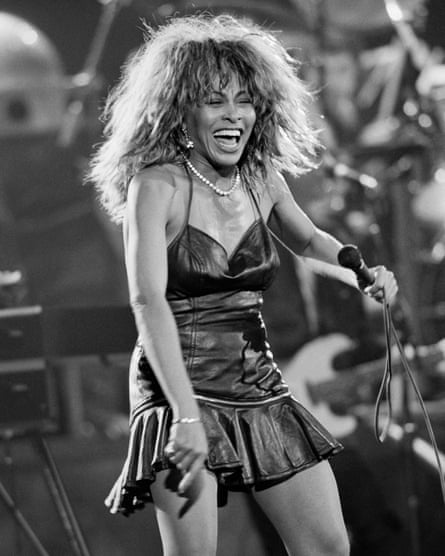Tina Turner, the pioneering rock’n’roll star who became a pop behemoth in the 1980s, has died aged 83 after a long illness.
She had suffered ill health in recent years, being diagnosed with intestinal cancer in 2016 and having a kidney transplant in 2017.
Turner affirmed and amplified Black women’s formative stake in rock’n’roll, defining that era of music to the extent that Mick Jagger admitted to taking inspiration from her high-kicking, energetic live performances for his stage persona.
After two decades of working with her abusive husband, Ike Turner, she struck out alone and – after a few false starts – became one of the defining pop icons of the 1980s with the album Private Dancer. Her life was chronicled in three memoirs, a biopic, a jukebox musical, and in 2021, the acclaimed documentary film, Tina.
In a statement on Wednesday night, her publicist Bernard Doherty said: “Tina Turner, the ‘Queen of Rock’n Roll’ has died peacefully today at the age of 83 after a long illness in her home in Kusnacht near Zurich, Switzerland. With her, the world loses a music legend and a role model.”
In 2018, scholar Daphne A Brooks wrote for the Guardian: “Turner’s musical character has always been a charged combination of mystery as well as light, melancholy mixed with a ferocious vitality that often flirted with danger.”
Turner was born Anna Mae Bullock on 26 November 1939 and raised in Nutbush, Tennessee, where she recalled picking cotton with her family as a child. She sang in the tiny town’s church choir, and as a teenager talked – or rather, sang – her way into Ike’s band in St Louis: he had declined her request to join until he heard her seize the microphone during a Kings of Rhythm performance for a rendition of BB King’s You Know I Love You.
After her vocal talents became apparent, Ike gave her the name Tina Turner – and trademarked it in case she left him and he wanted to replace her in his act. He quickly became abusive: when Turner tried to leave the group early on after having got a sense of his mercurial character, he hit her with a wooden shoe stretcher.

“My relationship with Ike was doomed the day he figured out I was going to be his moneymaker,” Turner wrote in her 2018 biography My Love Story. “He needed to control me, economically and psychologically, so I could never leave him.”
She made her recorded debut under the name with the Ike and Tina Turner single A Fool in Love in July 1960, which broke the US Top 30 and started a run of respectable chart success. But it was their live performances that made them a sensation. Ike toured the Ike and Tina Turner Revue aggressively on the Chitlin’ Circuit – including in front of desegregated audiences, such was their commercial power. In 1964, they signed to Warner Bros imprint Loma Records, which released their first album to chart: Live! The Ike & Tina Turner Show.
In the second half of the 60s, the duo were courted by many of rock’s biggest names. Phil Spector produced the 1966 single River Deep – Mountain High; they supported the Rolling Stones in the UK and later the US, and stars including David Bowie, Sly Stone, Cher, Elvis Presley and Elton John came to their Las Vegas residency.

They were a chart-making, Grammy-winning force in the 1970s – a run that came to an end when Turner left Ike, who had been consistently violent and unfaithful, in 1976. Her last single with the group was Baby, Get It On, from the 1975 film adaptation of the Who’s rock opera Tommy, in which she starred as Acid Queen, a character of the same name of her second solo album.
In the divorce, finalised in 1978, Turner came away with just two cars and the rights to her stage name. “Ike fought a little bit because he knew what I would do with it,” she said in the documentary Tina.
Turner, who had already released two solo records, continued pursuing a solo career, though it would take until she released her fifth album, 1984’s Private Dancer, for her to supplant the old image of the shimmying rock’n’roller – and escape premature relegation to the oldies circuit – with one of a powerful, mullet-sporting, leather-clad pop icon.

In the documentary Tina, she described Private Dancer as her debut. “I don’t consider it a comeback,” she said. “Tina had never arrived.”
Turner credited Buddhism and particularly the practice of chanting with positively affecting her life in the 1980s. Outside music, she starred in Mad Max Beyond Thunderdome opposite Mel Gibson in 1985. She published her first memoir, the global bestseller I, Tina, in 1986, which was later adapted in to the 1993 film What’s Love Got to Do With It? starring Angela Bassett as Turner. In 1995, she sang the theme tune to the James Bond film GoldenEye.
Turner announced her retirement in 2000, a year after releasing her final solo album, Twenty Four Seven, though she would return to the stage in 2008, performing at the Grammy awards with Beyoncé, and for a final tour to mark 50 years of her career.
That was conclusively the end. “I was just tired of singing and making everybody happy,” she told the New York Times in 2019. “That’s all I’d ever done in my life.”
Turner collaborated on the musical Tina with Phyllida Lloyd, which premiered in 2018 and won Laurence Olivier and Tony awards for its respective West End and Broadway runs. “This musical is not about my stardom,” Turner said of the production. “It is about the journey I took to get there. Each night I want audiences to take away from the theatre that you can turn poison into medicine.”
Turner often said she did not relate to the “invincible” persona that others put on her. “I don’t necessarily want to be a ‘strong’ person,” she told the New York Times. “I had a terrible life. I just kept going. You just keep going, and you hope that something will come.”
In 2020, a remix of her 1984 hit What’s Love Got to Do With It? by the Norwegian producer Kygo made Turner the first artist to have a UK Top 40 hit in seven consecutive decades. In 2021, she was inducted into the Rock and Roll Hall of Fame as a solo artist, 30 years after Ike and Tina Turner’s induction.
Turner is survived by her second husband, German music executive Erwin Bach. They married in July 2013 after 27 years together and lived in Switzerland. In 2013, Turner renounced her US citizenship to become a Swiss citizen.
Her first child, Craig Raymond Turner, died in July 2018. Last year, Turner said that following her other son Ronnie’s death at the age of 62 that he “left the world far too early”. She is survived by two of Ike Turner’s sons, Ike Turner Jr and Michael Turner, whom she adopted.
In 2020, Turner told the Guardian that despite having some serious health problems, the last 10 years of her life had embodied her ideal vision of happiness.
“True and lasting happiness comes from having an unshakeable, hopeful spirit that can shine, no matter what,” she said. “That’s what I’ve achieved, and it is my greatest wish to help others become truly happy as well.”

